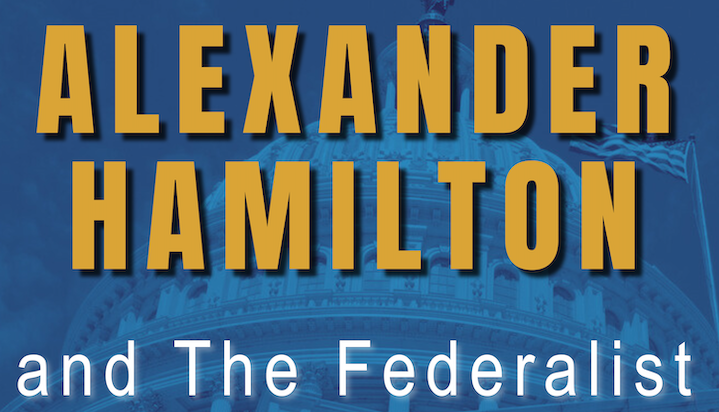Alexander Hamilton and The Federalist
October 22, 2025

Join The American Idea’s Listener Email list – get news about upcoming episodes and a chance to offer questions for them, too!
James Madison may be remembered as the father of the Constitution, but Alexander Hamilton deserves recognition as its most ardent interpreter and defender. While Hamilton’s impact at the Philadelphia Convention of 1787 proved limited—outnumbered two-to-one by fellow New York delegates opposed to dramatic changes under the Articles of Confederation—his greatest contributions to constitutional ratification emerged after the convention adjourned.
Returning to New York, Hamilton confronted a political landscape stacked against ratification. Governor George Clinton and his political machine flourished under the existing Articles of Confederation. New York City prospered while other regions struggled with economic dislocation, creating little appetite for constitutional revolution among Clinton’s allies or the broader public. The odds appeared dire.
Yet Hamilton refused to accept defeat. His wartime experience had shown him the stakes. Having literally risked his life for American independence at Yorktown and throughout the Revolutionary War, he would not watch that cause endangered during peacetime. Sometime in late September or early October 1787, he decided to write a series of essays defending the proposed Constitution. He enlisted James Madison from Virginia and fellow New Yorker John Jay to join the effort.
The Architecture of The Federalist
Of the 85 essays that became The Federalist Papers, Hamilton authored 51. Madison contributed 29, while Jay, who fell ill early in the project, managed only five. Hamilton drove the entire enterprise, outlining the structure in Federalist No. 1 and pushing his co-authors to contribute despite frustrating delays in correspondence between New York and Virginia.
The first fourteen essays addressed the utility of union to the happiness of the American people. Subsequent essays examined separation of powers, checks and balances, and the specific architecture of the proposed government. Jay focused primarily on foreign policy. Madison dealt extensively with Congress. Hamilton concentrated on the presidency and judiciary, laying out a vision of federal power that would shape American government for centuries.
The American Question
Hamilton opened Federalist No. 1 with a challenge that captured the existential stakes of ratification: “It has been frequently remarked that it seems to have been reserved to the people of this country to decide by their conduct and example the important question whether societies of men are really capable or not of establishing good government from reflection and choice or whether they are forever destined to depend for their political constitutions on accident and force.”
This framing reveals an often-overlooked dimension of Hamilton’s character. Critics sometimes portray him as a cold-hearted realist focused solely on building financial and military institutions. Yet his writings demonstrate genuine belief in the American experiment as humanity’s test case for self-government. He envisioned America as an “empire of liberty,” a phrase more commonly associated with Thomas Jefferson, combining romantic idealism with practical institution-building.
Hamilton also warned against demagogues who would undermine republican government by flattering the people, exploiting their passions and fears to seize power, then turning against those who elevated them. This warning appeared at both the beginning and end of The Federalist Papers, suggesting Hamilton viewed demagoguery as among the gravest threats to the republic.
The Failure of Confederation
Hamilton’s Revolutionary War service fundamentally shaped his constitutional vision. He and George Washington never forgot the desperate shortages of supplies and manpower that nearly doomed the Continental Army. State governments failed to deliver basic necessities, while the Confederation Congress lacked power to compel cooperation. America won independence perhaps by the skin of its teeth, conducting war by committee and voluntary contributions against the world’s greatest superpower.
In Federalist No. 15, Hamilton identified what he called the “great radical vice” of the Articles of Confederation: legislative power operated through state governments rather than directly on individuals. This meant the national government was not properly a government at all. Having won independence through near-miraculous struggle, America now risked losing the peace.
The proposed Constitution would enable the central government to obtain necessary funding and maintain military strength, allowing the newly independent nation to survive in a world of hostile powers. Hamilton believed union would produce strength, while separation into thirteen competing states would invite foreign adversaries to exploit differences and orchestrate disintegration.
He also saw the stronger federal government as essential for protecting property rights and maintaining the rule of law. Recent events like Shays’ Rebellion in Massachusetts had demonstrated that state governments might prove unable to quell domestic uprisings. A president charged with taking care that the laws be faithfully executed could prevent the kind of lawlessness and faction that historically destroyed republics.
The Energetic Executive
Hamilton’s defense of Article II provoked particular controversy. Anti-Federalists warned that the proposed presidency represented the “fetus of monarchy,” incompatible with republican government. Hamilton countered that successful republics required energetic executives.
Beginning around Federalist No. 68, Hamilton argued that the president needed powers even less extensive than those already possessed by the governor of New York. He then proceeded to articulate his vision of executive energy characterized by decision, activity, secrecy, and dispatch. Presidents must respond quickly to foreign attacks or domestic insurrections, sometimes moving independently without congressional authorization. Once American soldiers are killed, Hamilton believed, war has begun regardless of formal declarations, and the president has both right and obligation to respond immediately.
Hamilton devoted considerable attention to defending a single executive against proposals for executive councils or multiple presidents. Unity ensures accountability. Citizens know whom to hold responsible for decisions and can impeach if necessary. A single president can move quickly to enforce the rule of law and protect property rights, safeguarding republican government against the internal faction and external threats that destroyed historical republics.
The president required what Hamilton called “competent powers” to fulfill these responsibilities: the veto, pardon power, and commander-in-chief authority. Duration mattered too. Hamilton personally favored presidents elected for life subject to impeachment, though he accepted four-year terms with unlimited re-eligibility. He hoped the Electoral College would ensure selection of individuals with high character, integrity, and talent, filtering democracy to identify national figures capable of governing a republic.
Hamilton envisioned the Senate as a partner in foreign affairs and national security, populated by community leaders elected by state legislatures rather than directly by voters. This additional filtering would produce senators with broader, less parochial perspectives who could work effectively with the president on treaty ratification and cabinet appointments.
The Judiciary and Rights
Hamilton called the federal judiciary “the least dangerous branch.” Lifetime appointments during good behavior, combined with legal culture’s emphasis on precedent, would produce judges faithful to constitutional text rather than public opinion or political experimentation. The law itself creates practitioners averse to radical change and inclined to protect established rights, particularly property rights.
Hamilton’s faith that judges would maintain this orientation may have proven overly optimistic. He perhaps should have anticipated the rise of more activist judicial philosophies. Nonetheless, his vision rested on the belief that immersing oneself in legal precedent produces a certain reverence for text and tradition incompatible with democratic election of judges, which would make them responsive to popular sentiment rather than constitutional principle.
In Federalist No. 84, Hamilton made an argument that subsequent history rendered controversial: the Constitution needed no separate Bill of Rights. Both he and Madison initially opposed such additions, believing the Constitution itself functioned as a bill of rights through separation of powers, checks and balances, and enumerated federal powers that preserved state authority.
Hamilton worried that listing protected rights posed risks. What if something important were omitted? Could any list fully enumerate every right deserving protection? Once rights were specified, might ill-intentioned leaders exploit gaps in that specification? The structure of limited government provided stronger protection than any catalog of particular liberties.
The Enduring Warning
Hamilton concluded Federalist No. 85 by returning to themes from his opening essay. The eyes of the world were upon America. If reflection and choice failed here, if republican self-government could not succeed in this most favorable circumstance, the implications would resonate through centuries. American citizens in 1787 and 1788 faced a rare choice whose consequences would extend far beyond their lifetimes.
That choice succeeded by the narrowest margins in New York, where Hamilton’s political courage and intellectual firepower helped overcome formidable opposition. His vision of energetic federal power, accountable executive authority, and structural protection for rights shaped American constitutional development in ways that continue generating debate. Whether societies can sustain government through reflection and choice rather than accident and force remains an open question, one each generation must answer through its own conduct and example.

